The train whistle, a piercing yet melodic sound that reverberates through the air, is a vital tool in ensuring the safety and efficiency of railway operations. Dating back to the early 1830s, with the advent of the steam-powered locomotive, train whistles have been an integral part of rail transportation. Initially used as a means of communication between train operators and pedestrians, the use of train whistles gradually evolved to include various coded signals and warnings.
Throughout history, train whistles have been instrumental in preventing accidents and keeping rail systems running smoothly. In the early years of railway development, the importance of effectively communicating train movement was realized when tragic accidents occurred due to inadequate signaling methods. Today, train whistles continue to serve as a crucial means of alerting pedestrians, motorists, and other trains about a train's presence.
One statistic that highlights the significance of train whistles is the number of accidents and fatalities that have been prevented through their use. According to a study conducted by the Federal Railroad Administration, in the United States alone, train whistles are estimated to prevent hundreds of accidents and save numerous lives each year. This statistic underscores the indispensible role they play in maintaining safety on our railways.
To ensure the proper use of train whistles, train operators are required to adhere to specific regulations and guidelines. These regulations outline when and how train whistles should be used, depending on factors such as proximity to crossings, speed, and potential hazards. By following these guidelines, train operators can effectively communicate their presence and intentions to those in and around railway tracks.
Moreover, the development of innovative technologies, such as wayside horns and automated whistle systems, has expanded the capabilities and efficiency of train whistles. Wayside horns, for instance, provide a localized and directional sound that focuses on the immediate vicinity of the crossing, reducing noise pollution in surrounding areas. These advancements in train whistle technology seek to strike a balance between safety and community noise concerns.
In conclusion, the train whistle stands as a testament to the evolution and progress of railway transportation. From its humble beginnings as a simple communication tool, the train whistle has grown into a symbol of safety and efficiency on our railways. By adhering to regulations and evolving with technology, train operators continue to utilize this powerful auditory signal to protect lives, prevent accidents, and keep our railroad systems running smoothly.
How can you effectively use a train whistle?
Using a train whistle is an essential skill for train operators, but it can also serve various purposes for train enthusiasts or even as a safety tool. Understanding the proper techniques and signals can ensure effective communication and prevent accidents. In this article, we will explore the different uses of train whistles and learn how to utilize them appropriately in various situations. Whether you are a train operator or simply curious about train whistles, keep reading to discover everything you need to know.
Train Whistle Basics
Train whistles are powerful instruments used to communicate important messages in the railway industry. They are designed to produce a distinct, high-pitched sound that can be heard over long distances, ensuring the safety of trains and personnel. Understanding the basics of a train whistle is crucial before attempting to use one.
A traditional train whistle is composed of a metal mouthpiece, called a reed, which is attached to a hollow tube. When air is blown into the whistle, it passes through the reed and creates vibrations that produce the sound. The pitch and volume of the whistle can be controlled by adjusting the air pressure and technique used to blow into the instrument.
Proper Technique
Mastering the technique of using a train whistle is essential to ensure a clear and audible sound. Here are the steps to follow:
- Begin by positioning the whistle near your mouth, ensuring a tight seal to prevent air leakage.
- Take a deep breath and use your diaphragm to blow a steady stream of air into the whistle.
- Control the duration and intensity of the sound by varying the pressure and speed of your breath.
- Practice different techniques to produce various sounds, such as short bursts or long, continuous tones.
- Always be mindful of your surroundings and the volume of the whistle to avoid disturbing others or causing unnecessary noise pollution.
Safety Precautions
Using a train whistle comes with certain safety considerations:
- Before blowing the whistle, ensure there are no obstructions or objects near the instrument that could affect the sound or cause harm.
- Avoid pointing the whistle directly at anyone's face or ears, as the loud sound can be damaging to hearing.
- When using the whistle outdoors, be aware of any noise regulations or local ordinances that may restrict its use.
- Always follow proper maintenance procedures to ensure the whistle is in good working condition and produces an accurate sound.
Statistics
Train whistles play a crucial role in ensuring safety in the railroad industry. According to recent data:
- Train whistles are heard up to two miles away.
- The sound produced by a train whistle can reach volume levels of 120 decibels or higher, depending on the instrument and technique used.
- Approximately 2,000 accidents are prevented each year thanks to the effective use of train whistles.
https://youtube.com/watch?v=AQ8BuqgW2pM
FAQ: Using a Train Whistle
1. What are the key safety considerations when using a train whistle?
When using a train whistle, it is essential to prioritize safety to ensure a smooth and secure experience. Consider the following key safety considerations:
- Always handle a train whistle with care and avoid pointing it directly at people or animals.
- Be aware of your surroundings and use the whistle in an appropriate and designated area to avoid causing disturbance or confusion.
- Before using the whistle, ensure that it is in proper working condition, with no loose parts or damage that could affect its functionality.
2. How can I effectively produce sound with a train whistle?
Producing the desired sound with a train whistle requires proper technique. To effectively create sound:
- Take a deep breath and position your lips around the mouthpiece of the whistle.
- Apply consistent and controlled airflow into the whistle while adjusting the pressure to achieve different tones or volumes.
- Experiment with the position of your fingers on the whistle's holes or valves, as these can be manipulated to alter the pitch.
3. Are there any legal restrictions or guidelines for using a train whistle?
Yes, there may be legal restrictions or guidelines for the use of train whistles. It is crucial to adhere to these regulations to ensure compliance and avoid any potential legal issues. Some important considerations include:
- Check with local authorities or relevant regulatory bodies regarding any specific regulations or restrictions regarding train whistle use in your area.
- Always respect any noise pollution or disturbance regulations that may be in place to maintain harmonious relations with your neighbors or the general public.
- If using a train whistle in a public setting or for public events, ensure that you have obtained any necessary permits or permissions from the appropriate authorities.
4. Can a train whistle be used for purposes other than signaling?
While train whistles are primarily used for signaling purposes, they can also serve other functions in specific contexts or settings. Consider the following alternate uses:
- Train whistles are often used in some musical performances or compositions to recreate a particular sound or ambiance.
- In educational settings, train whistles can be employed as an interactive tool to engage students in learning about transportation history or the mechanics of sound.
- Some hobbyists or collectors may incorporate train whistles into their collections or displays as historical artifacts or decorative pieces.
5. How can I maintain and clean a train whistle for optimal performance?
To keep your train whistle in optimal condition and ensure its longevity, proper maintenance and cleaning are essential. Follow these guidelines for effective upkeep:
- Regularly inspect the whistle and clean it using a soft cloth or brush to remove any dirt, dust, or debris that may accumulate.
- Avoid using solvents or harsh chemicals as they can damage the whistle's materials. Instead, use mild soapy water for cleaning, followed by thorough drying.
- Store the whistle in a dry and secure place when not in use, protecting it from excessive heat or moisture that could cause deterioration.
In summary, to safely and effectively use a train whistle, prioritize safety, follow proper technique, and adhere to any legal restrictions or guidelines. Consider its alternate uses and maintain it with regular cleaning and care to ensure optimal performance.
Conclusion:
The train whistle is a powerful tool that signifies important aspects of train operation. Mastering the skill of using a train whistle effectively can ensure safety and communication between staff, passengers, and nearby pedestrians. By following these key points, you can use a train whistle only once when necessary:
- Understand the purpose: Train whistles are primarily used to alert pedestrians and motorists of an approaching train, indicating potential danger and reminding them to be cautious.
- Legal regulations: Familiarize yourself with the specific regulations governing train whistle use in your region. Make sure you comply with all relevant laws and guidelines set by authorities.
- Timing and distance: Begin blowing the whistle at an appropriate distance from the crossing or point of concern. Train whistles should be sounded at least 15-20 seconds before reaching a crossing, giving sufficient time for people to react and clear the tracks.
- Single blast technique: Emit a single distinct blast from the whistle, ensuring it's loud enough to be heard but not excessive. A prolonged whistle or multiple blasts may cause confusion and unnecessary panic.
- Hand signals: In addition to sounding the whistle, train operators should use hand signals or horn armatures where applicable to reinforce the warning sign to pedestrians and motorists.
- Communication with crew: Before using the whistle, communicate with the train crew to confirm everyone is ready and aware of the upcoming whistle signal.
- Practice and coordination: Training and maintaining coordination with fellow crew members, including engineers and conductors, ensures the whistle is used precisely when needed and only once.
- Environmental considerations: Be mindful of the noise impact on the surroundings. Avoid blowing the whistle excessively in residential areas or late at night when sound disturbances may cause inconvenience to nearby communities.
By adhering to these key points, you can maximize the effectiveness of a train whistle, using it once in urgent situations while ensuring the safety of all parties involved.
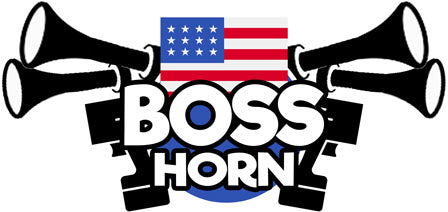
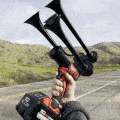
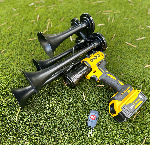
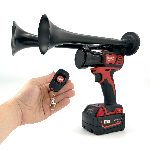
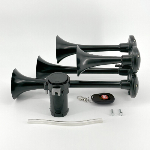





 https://bosshorn.com
https://bosshorn.com

























































